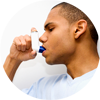Heat Stress and Employer Readiness
In this webinar, you will learn about:
- Employer practices to mitigate occupational heat stress and heat-related illness
- A successful employer-based occupational heat stress illness prevention program
Presented by:
Ronda McCarthy, MD, MPH, FACOEM, national director of medical surveillance services
Melissa Hay-Boggs, director of product development
Host
0:00
Hello, and welcome to the Concentra webinar: Heat Stress and Employer Readiness. Today's webinar will be presented by Concentra’s National Medical Director of Medical Surveillance Services Dr. Ronda McCarthy and Director of Product Development Melissa Hay-Boggs. At the conclusion of the presentation, we will have a 10-to-15 minute Q&A session with the presenters. You can submit your questions throughout the presentation to be answered during the Q&A session. We will answer as many questions as possible within the time allowed. A recording of the webinar will be e-mailed to you after the presentation so you can view it again at your convenience. We're ready to begin.
Melissa Hay-Boggs
0:43
Thank you, Anna. We'll start by covering some of the learning objectives for today. Occupational heat and heat-related illness conversations are becoming more and more prevalent. How can employers anticipate adverse heat-related health effects on employees when research on heat stress in work settings is so scarce? Today, we're going to examine employer practices to mitigate occupational heat stress and heat-related illness. We're also going to discover the results of a successful employer-based occupational heat stress prevention program. First of all, begin with a little bit about increased ambient temperatures.
Heat stress is pervasive
1:31
Heat stress is a global phenomenon. In the past 140 years of National Oceanic and Atmospheric Administration data, five of the warmest years on record have occurred since 2015. In January, the NOAA and NASA declared that the hottest decade on record was from 2009 to 2019. Extreme temperatures or increased ambient temperatures are in every region of our country. What does that mean for us? It means longer hot seasons, more days over 90 degrees Fahrenheit, and an increased frequency and duration of heat waves. With this, comes the health effects of extreme temperatures. Dr. McCarthy, I'd like to hand it off to you now to share information about the health effects of extreme temperatures on employees.
Dr. Ronda McCarthy
2:32
Thank you, Melissa. The health impact of increased ambient temperatures on those populations that are most exposed to hot environments will be compounded. OSHA states that every year thousands of employees become ill from occupational heat exposures, some fatally. Over the years, heat-related illnesses have been under recognized and underreported for a variety of reasons. But recently, there has been an emphasis on understanding, heat stress and heat-related illness. And with this additional awareness, we also know, as OSHA states, heat illnesses and fatalities are preventable. Next slide.
[Heat Stress and Its Impact on Workers, Direct Effects of Heat Stress]
Direct and indirect impacts of heat stress
3:21
Occupational heat exposure has direct and indirect impacts. The direct impact of excessive heat exposure can range from heat rash to heat stroke, which can be fatal. Heat-related illnesses, such as heat exhaustion, must be taken seriously. Heat exhaustion can quickly lead to heat stroke if not addressed. Heat stroke is a medical emergency. Any delay in treatment increases the employee’s risk of permanent organ damage and death. Heat stroke is differentiated from heat exhaustion by higher core body temperatures, neurologic involvement, and multi-organ system dysfunction. Other serious heat-related illnesses include dehydration, rhabdomyolysis, renal failure, and chronic kidney disease. The key point to remember is that heat-related illnesses and deaths are preventable.
[Heat Stress and Its Impact on Workers, Indirect Effects of Heat Stress]
4:20
On this slide, we have examples of the indirect effects of heat stress, which impact the entire company. For example, a forklift driver for a large manufacturing company is loading semi-trailers on a hot, humid warehouse in mid-July. His safety glasses become fogged. He becomes disoriented, running his forklift into a stack of products, injuring himself and a co-worker. The employer’s accident investigation reveals that prior to the incident the forklift driver was operating at 50 percent reduced performance and had complained to a supervisor of having headaches and fatigue. The driver was offered ibuprofen and some coffee and was encouraged to complete the shift because of distribution demand. Now, the employer has two OSHA-recordable workers' compensation claims.
5:08
Heat stress does have indirect effects, including increased accidents, reduced work performance, and increased costs, such as health care and workers' compensation costs. Next slide.
Understanding the risk factors
[Heat Stress: Risk Factors, Thermal Environment]
To create a site-specific program for the prevention of heat-related illness or injury, you must first understand worker specific risk factors. These risk factors can be grouped into three main categories: environmental, job-specific, and personal.
The National Institute for Occupational Safety Health (NIOSH) publishes recommended occupational exposure limits for heat stress. These limits are consistent with those of the American Conference of Governmental Industrial Hygienists (ACGIH) threshold limit values for heat stress and strain, which specify a maximum combination of environmental heat, measured as WetBulb globe temperatures and metabolic heat workload or the job-specific to which workers can be exposed.
6:12
Exposure limits are lower for those workers who are un-acclimatized to heat who wear work clothing that inhibits heat dissipation. You also have predisposing personal risk factors. So those would be the individual personal risk factors.
[Heat Stress: Risk Factors, Thermal Environment]
6:30
On this slide, we'll look at thermal environmental risk factors. Environment is an obvious risk factor that most of us can agree on. But we must take it take into account measurements captured by the WetBulb globe temperature, which is temperature, humidity, wind, speed, and solar radiant heat. If the WetBulb globe temperature measurement is not available, other vital environmental risk factors to consider include the heat index. Also, is the work site urban or rural? Keep in mind the urban heat island effect. Is a work primarily indoor with exposure to furnace or other hot surfaces? Or is the employee working outdoors with exposure to radiant heat from the sun or is the work a mixture of both?
[Heat Stress: Risk Factors, PPE & Clothing, Work Demands]
7:27
On this slide are job-specific risk factors that can increase employees’ metabolic heat load and net heat load. And they include the worker's physical demand, which may be moderate, heavy, or very heavy, such as for a firefighter, which are defined by the ACGIH. Duration of exposure needs to be considered. Do you have eight-hour shifts, 12-hour shifts, overtime, or shiftwork. Second shift tends to be the hottest shift. Protective personal equipment must be considered, such as respirators and hardhats. Right now, with the COVID-19 pandemic, we have many more employees wearing respirators, usually N95, as part of the job requirement. This is important to keep in mind because workers exposed to heat with a respirator may add additional heat stress by the fact that they are covering their face and their head, especially if it's more than N95, and this can increase the cardiovascular demands of the individual. Respirators also impede person from maintaining hydration.
8:34
Next slide.
[Heat Stress: Risk Factors, Personal]
There are also personal risk factors to keep in mind as the net individual thermal load. These factors affect the employee’s ability to thermal regulate the external and internal heat load. They are less obvious but a very important factor in a heat illness prevention program. The COVID-19 pandemic also adds another complexity for employees returning from furlough back to a hot work environment. And we are approaching summer as well for those outdoor workers. Individuals who've been out for a few months may have become more physically unfit. They have poor physical fitness. Now, if they have exposure to indoor heat, they've become un-acclimatized to the heat as well.
9:29
Next slide.
Heat stress prevention programs
[Heat Stress Prevention Programs]
So, we have reviewed the employers’ risk factors and the specific worksite risk factors that can contribute to heat stress. So now let's look at a specific heat stress prevention program.
Melissa Hay-Boggs
9:52
Thank you, Dr. McCarthy, for covering the risk factors. Just to share a little bit about heat stress prevention programs; there are a few things that employers need to consider upfront. First, what are the applicable state or federal regulations? Currently, OSHA does not have a heat standard. Therefore, employee protection must fall under OSHA’s general duty clause, which states that employers must provide employees work environments that are free from recognized hazards that are causing or are likely to cause death or serious physical harm.
But there are also a few states that have a specific heat standard in place today. Those are California, Minnesota, Washington, and the US. military. By 2022, Maryland will also have a state-specific heat standard.
Dr. Ronda McCarthy
10:47
Thank you, Melissa. When developing a heat stress prevention program, use your existing federal or state standards for general industry or construction industry that provides for personal protective equipment, such as cooling vests, potable water, training to render first aid, avoidance of unsafe conditions, adequate first aid supplies and provisions for medical care. Be sure that you're meeting these existing standards.
11:23
Next slide.
[Heat Stress Prevention Programs, Essential Resources]
Other essential resources that may be used to develop specific heat stress prevention programs are the OSHA Technical Manual, Chapter 4 on Heat Stress and NIOSH’s Criteria for a Standard: Occupational Exposure to Heat and Hot Environments, which is referenced throughout OSHA's Technical Manual. In this way, you are ensuring you meet OSHA's expectations for worker health and safety.
[Heat Stress Prevention Program Hierarchy of Controls]
11:56
We have assessed the site-specific risk factors, taken into account the applicable federal and state mandates. Now, using OSHA and NIOSH resources, let's apply the hierarchy controls for occupational heat exposure. As most of you are aware, elimination of the exposure is the most effective control. PPE controls are the least effective. The heat stress prevention program that we will discuss will focus primarily on the levels in between engineering and administrative controls.
[Controls by Heat Index Risk Level]
12:32
This slide shows an overview of the basic controls common to most heat stress prevention programs. These controls are implemented by risk level based on heat index. When the heat index reaches about 90 degrees, then have in place provisions of drinking water, medical services, supervisor and employee training on heat stress, heat-related illness, and first aid, and your accommodation plan. Each risk level above adds the below measures to the prior risk level. You can find more information on this and on this concept using the heat index as a level of administrative controls in the guide to employer resources that are linked at the end of this presentation.
[Heat Stress Prevention Program, Engineering Controls]
13:32
Let's look at engineering controls. Basically, if you cannot eliminate the heat, cool the environment. Engineering controls that factor into the WetBulb globe temperature are the most effective. Decreasing the temperature by air conditioning or providing cooling booths or air conditioned break rooms, increasing the wind speed, ventilation, cooling fans, decreasing the solar radiant heat with shade, decreasing humidity, exhausts fans near heat and moisture production. This slide shows an example of outdoor hearing can heat engineering controls by provision of shade.
[Heat Stress Prevention Program, Personal Protective Equipment and Clothing]
14:19
The next slide shows personal protective equipment considerations that include water-cooled garments, cooling vests, and wetted overgarments. Also, when working outdoors, clothing should be loose-fitting, light colored, and lightweight. Long sleeves should be included when environmental temperatures exceed body temperatures.
[Heat Stress Prevention Program, Administrative Controls]
14:44
Administrative controls are many, and these changes can be made with some planning and little to no cost. As I showed before on the prior slide, they can be implemented as the heat index rises. They are some of the key factors in preventing heat-related illnesses, and they are very common to most work sites. Let's look more closely at these.
Heat acclimatization is vital
[Heat Stress Prevention Program, NIOSH-recommended Acclimatization Plan]
16:10
On the next slide, you'll see an example of a NIOSH-recommended acclimatization plan for when an acclimatized employee has been away from the work site, either for an illness or a vacation. Also, underneath is an explanation of acclimatizing new employees to the work site, that is, new hires that are going directly into a hot environment. This is a key administrative control. It should be included in all heat stress prevention programs for newly hired employees and those employees returning from an absence. A study of US occupational heat-related illnesses and fatalities from 2011 to 2016, published in the Monthly Morbidity and Mortality Weekly Report in 2018, showed that 80 percent of heat exposure deaths reviewed occurred in un-acclimatized employees in their first week or two of work, and there are several studies that are consistent with these findings.
16:35
Next slide.
[Heat Stress Prevention Program, Supervisor and Employee Training]
16:39
Another key administrative control is supervisor and employee training. In my experience implementing heat stress prevention programs, there are so many misunderstandings or myths about heat stress and how employees should take care of themselves when they get hot. Their understanding of what they should do would more than likely make their chance for a heat-related illness occur more quickly and cause it to occur than actually prevent heat-related illness. So, education is key. Employees and supervisors should understand the signs and symptoms of a heat-related illness and understand that immediate response is absolutely necessary. In high heat conditions, the buddy system is important as is access to communication because those who are have heat exhaustion or near heatstroke can have neurologic changes where they may not know to seek immediate help. They need that buddy to go ahead and access that emergency response for them.
Downloadable heat stress smartphone app
17:51
Next slide.
[Supervisor and Individual Resources, OSHA-NIOSH Heat Safety Tool from the CDC]
A great resource for supervisors and employees alike is the OSHA-NIOSH Heat Safety Tool from the CDC. I even recommend this to the general public. The NIOSH Heat Safety Tool is a free, downloadable app for a smartphone, and it shows the current local heat index conditions. It gives you an hourly, predicted forecast throughout the day and provides a risk level for heat-related illness. It provides precautions, gives you signs and symptoms of heat-related illness, and first aid should heat illness occur.
18:31
Next slide.
[Heat Stress Prevention Program, Medical Monitoring and Surveillance]
19:25
Another important factor for a heat stress prevention program if you have workers exposed above NIOSH-recommended exposure levels, and this information is provided by OSHA and NIOSH, whether they are acclimatized or not, should be a medical monitoring program with the goal to minimize employees' health and safety from heat hazards. It also provides feedback to employers on their prevention programs. The medical monitoring should be both pre-placement and periodic or annually. The clinician who provides the medical monitoring should provide a written medical opinion to the employer to provide information whether the employee is safe to work in the heat and hot environment or if they need any accommodation or further evaluation for any uncontrolled medical conditions.
19:27
Next slide.
[Heat Stress Prevention Program, Medical Monitoring]
The medical monitoring evaluation should include medical and occupational history with emphasis on past, present, and anticipated exposure to heat and hot environments. It should include history of prior heat illness, if the employee has any risk factors for heat, for heat related illness, and the exam should have emphasis on their weight, their vital signs, cardiovascular system, respiratory scan, among others. There can be laboratory testing that is included, based on their medical history and physical exam to further confirm if they are safe to work in a hot environment.
[Heat Stress Prevention Program, Medical Surveillance]
20:20
To evaluate the effectiveness of a heat stress prevention program, review data annually. Safety and health managers can look at heat-related illness frequency, worker's compensation costs, and job specific heat-related illnesses to make control interventions accordingly.
Documented success of heat stress program
[Impact of a Heat-related Illness Prevention Program]
20:44
I would like to share with you the results of a successful employer-based Occupational Heat Related Illness Prevention Program. This is retrospective analysis of data collected, and it was published in the Journal of Occupational and Environmental Medicine in September 2019. The analysis looked at heat-related illness occurrences in a group of outdoor municipal workers before and after the implementation of the Heat Illness Prevention Program. This research and analysis was made possible by my co-investigators at the University of Pennsylvania. It was a program I ran as a medical director for a municipality. Then, as I am an adjunct professor at the University of Pennsylvania, I worked with Dr. Fran Shofer and Dr. Judith Green-McKenzie to provide these results.
21:45
We looked at outdoor employees who had a job description of moderate to very heavy physical demands with exposure to extreme heat that was included in their job description. Basically, I began the program when I noticed that the employer had several heat-related illnesses that were occurring. I'm from central Texas where we have a very hot, humid climate. I did exactly what we discussed just now. I looked at the OSHA Technical Manual on Heat Stress and the NIOSH Criteria for a Standard, which has been revised since I started with reviewing the standard. I implemented the administrative and engineering controls, where possible. We provide employee and supervisor training, provision of water, rest shade and the medical monitoring. We provided all employees with those provisions, and we also had an acclimatization plan, as well. But, employees who were at higher risk for heat stress, which were identified on a screening questionnaire, we gave more individual heat-related illness prevention program training that was specific to their risk factors. And then those that were identified to have uncontrolled specific individual risk factors – since these were outdoor employees – we did most of the medical monitoring in the early spring, before it became hot, and gave them a chance to get those factors controlled before it became hot. Even though that they were restricted from working in a hot environment, it was not yet become hot, so they most were not taken off work. And then, those that had trouble with some personal chronic health condition, we offered them periodic checks throughout the hot season to ensure that they remained under control. So, what were our findings?
24:07
We did this for about seven years. We had two years of data before and then we did this for about seven years. It was about year five and seven that I realized we ought to look back at this data because we had good results with the implementation of this program. We found that employees with two or more individual personal risk factors for heat-related illness were more likely to develop a heat-related illness. We also found that the median workers' compensation costs went down by 50 percent per illness and this was thought to be due to the training and early identification. So, persons came in quicker when they had signs or symptoms; therefore, their illness was less severe, so less costly. It was per illness.
25:02
Next slide.
[Before and After Heat Stress Awareness Program]
Finally, the total number of heat-related illness cases decreased after implementation of the heat stress prevention program. In fact, in the last few years, there were no reported cases of heat-related illness during the hot season. As you recall earlier on the section that Melissa discussed about climate, the period from 2009 to 2019 was recorded as the hottest decade by the National Oceanic and Atmospheric Administration in its 140-year history. So this was in the hottest decade, and I think 2016 is one of the hottest years on record, as well. We went from about 27 to 24 per thousand heat-related illnesses; 2011 was actually a really, really hot year. I was expecting us to get more reports because people were understanding what heat-related symptoms were, so I thought we would actually get more reports. That was also a very hot year. We gradually went down to where we had no illnesses. This was a municipality that does not have to report to OSHA as far as their work injuries, so there was no issue regarding recordability. They had their own employee health program, and employees felt free to come in and provide reports regarding any injury or illness.
26:42
Next slide.
[Key Takeaways]
The key takeaways:
- Heat related illnesses are 100 percent preventable
- Research supports, prevention programs’ effectiveness in reducing heat-related illness and associated workers' compensation costs
- Prepare now for occupational heat stress, its associated hazards, and its impact on productivity, direct and indirect costs, and most importantly, the health and safety of your workforce.
The next slide shows some links to some important areas that you can utilize for your own prevention programs and just information that is just very helpful when needing additional resources regarding heat illnesses or for first aid and safety and emergency response. Thank you so much.





